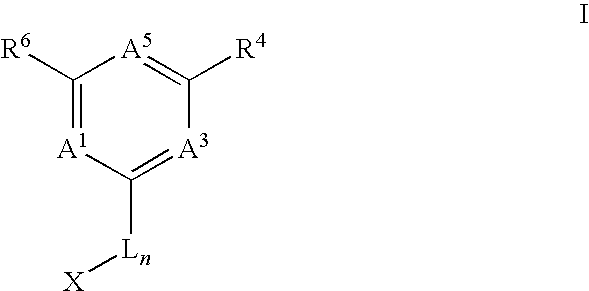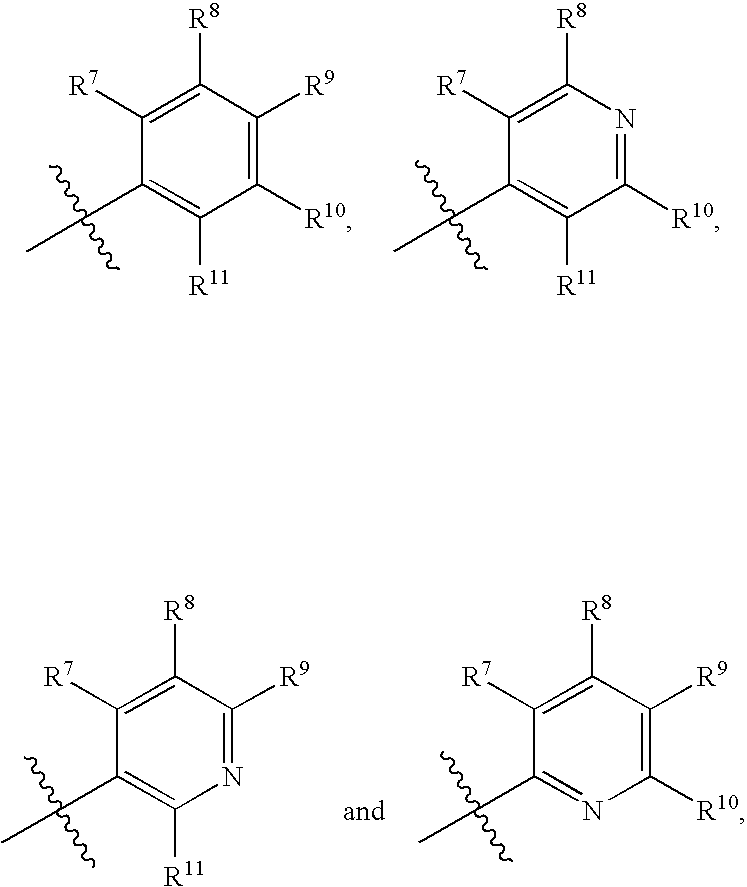Anti-cancer agents and uses thereof
a technology of anti-cancer agents and active ingredients, applied in the field of anti-cancer agents, can solve the problems of unchecked cell growth and proliferation leading to cancer development, and achieve the effect of hindering or blocking the cell cycle progression
- Summary
- Abstract
- Description
- Claims
- Application Information
AI Technical Summary
Benefits of technology
Problems solved by technology
Method used
Image
Examples
example 1
1,3-DIBROMO-5-NITROBENZENE
[0387](The named compound was synthesized according to Dumont, Bull. Soc. Chim. Bel., 505 (1995). This compound is also commercially available from Karl Industries, Aurora, Ohio) To a suspension of 2,6-dibromo-4-nitroaniline (75.0 g, 254 mmol) in ethanol (1 L) was added H2SO4 (100 mL). The mixture was heated to reflux and sodium nitrite (50.5 g, 730 mmol) was added portion-wise over a period of 15 min. The mixture was heated at reflux for 3 h and was then cooled to room temperature. The formed thick suspension was poured on ice water (1000 mL) upon which more solid precipitated. The solid was filtered and the filter cake washed with water (2×250 mL) and dried in an oven at 20 mbar / 30° C. to give 66.2 g (93%) of 1,3-dibromo-5-nitrobenzene as a brown solid.
example 2
3,5-DIBROMO-1-BENZYLOXYBENZENE
[0388](According to Effenberger, Chem. Ber. 163 (1991).) 1,3-dibromo-5-nitrobenzene (2.81 g, 10.0 mmol), freshly powdered potassium hydroxide (1.00 g, 17.8 mmol) and tetrabutylammonium bromide (0.32 g, 1.00 mmol) were dissolved in tetramethyl urea (TMU, 8 mL). Oxygen was bubbled through the reaction mixture for 5 min and a solution of benzyl alcohol (1.30 g) in TMU (2 mL) was added drop-wise at room temperature over a period of 1 h. The mixture was stirred for 6 h at room temperature during which oxygen was bubbled through. The reaction mixture was poured on ice (30 g) and was extracted with tert-butylmethyl ether (2×50 mL). The combined organics were dried (MgSO4) and concentrated to give the crude product which was purified by FC (120 g SiO2, AcOEt / heptane 1:4) to provide 3.15 g (92%) of 3,5-dibromo-1-benzyloxybenzene.
example 3
3,5-DIBROMO-1-P-METHOXY-BENZYLOXYBENZENE
[0389]1,3-dibromo-5-nitrobenzene (30.0 g, 107 mmol), freshly powdered potassium hydroxide (10.8 g, 192 mmol) and tetrabutylammonium bromide (3.42 g, 10.7 mmol) were dissolved in tetramethyl urea (TMU, 90 mL). A solution of p-methoxybenzyl alcohol (17.8 g, 128 mmol) in TMU (30 mL) was added drop-wise at room temperature over a period of 1 h. The mixture was stirred for 48 h at room temperature. The reaction mixture was poured on ice (160 g) and was extracted with tert-butylmethyl ether (4×200 mL). The combined organics were dried (MgSO4) and concentrated to give the crude product which was purified by FC (2.5 kg SiO2, AcOEt / heptane 1:9) to provide 29.6 g of 3,5-dibromo-1-p-methoxy-benzyloxybenzene which was not completely pure but which crystallized upon standing. The solid was taken up in methanol (27 mL) and the formed slurry was stirred at 60° C. for 10 min. The suspension was cooled to 0-5° C. and was then filtered. The filter cake was wash...
PUM
 Login to View More
Login to View More Abstract
Description
Claims
Application Information
 Login to View More
Login to View More - R&D
- Intellectual Property
- Life Sciences
- Materials
- Tech Scout
- Unparalleled Data Quality
- Higher Quality Content
- 60% Fewer Hallucinations
Browse by: Latest US Patents, China's latest patents, Technical Efficacy Thesaurus, Application Domain, Technology Topic, Popular Technical Reports.
© 2025 PatSnap. All rights reserved.Legal|Privacy policy|Modern Slavery Act Transparency Statement|Sitemap|About US| Contact US: help@patsnap.com



